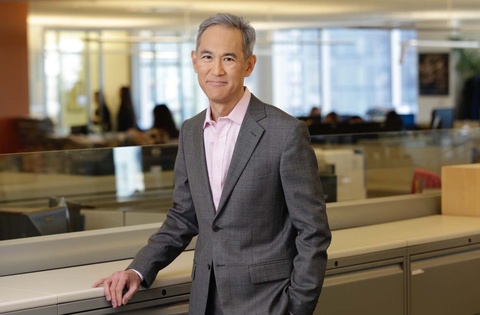From Japanese society to white society
Thirty years ago when I moved to Los Angeles, Tricia Toyota was a Japanese-American anchor who played a major role in local television news. I still remember the footage of her flying to the site to interview victims of the Great Hanshin-Awaji Earthquake in 1995. Other famous "Japanese-American journalists" include sports anchor Rob Fukuzaki and KABC anchor David Ono, who was awarded the Order of the Rising Sun, Gold Rays with Rosette by the Japanese government in the fall of 2021.
Fred Katayama, who I had the opportunity to interview online in the summer of 2022, is a former Japanese-American journalist who has worked for NHK, CNN, and Reuters Television. Currently serving as vice president of the U.S.-Japan Council, he has moved on from the world of journalism, but has nearly 40 years of industry experience.
I met Fred at a party hosted by a certain organization in Los Angeles before the pandemic. I met Fred again two years later at a party hosted by the same organization, where I was impressed by his fluent Japanese despite being a Japanese-American. At that time, his title had changed from "Reuters Television anchor" to "Vice President of the U.S.-Japan Council." I was interested in why he had switched careers from journalism to a non-profit organization for Japan-U.S. exchange and what his background was, so I applied to interview him, who lives in New York.
Fred was born in Los Angeles in 1960 and grew up in Monterey Park, an eastern suburb of Los Angeles. Both of his parents were second generation Japanese. Although he is a third generation Japanese, his Japanese language skills are based on his parents being second generation Japanese. Furthermore, he grew up surrounded by Japanese people because he attended a Catholic school established for Japanese Americans and a Japanese language school on weekends.
Fred experienced an identity crisis when he entered Loyola High School near downtown. He was suddenly surrounded by white people, and his feelings became confused and he began to think, "Shouldn't I behave like a white person?" Fred said with a hint of self-deprecation, "At that time, I was a banana (yellow skin, white inside)."
Meeting with a mentor
But then a major turning point came. He met Tricia Toyota, mentioned above, at Nisei Week. "When I was a teenager, Tricia started appearing on the news on KNBC and I became an avid watcher of her news. I followed her, who was a guest at Nisei Week, and mustered up the courage to tell her, 'I want to be a journalist,' and ask for her autograph. She then offered to show me around the TV station, and actually volunteered to be my guide."
Fred became interested in the news after hearing about the assassination of President Kennedy when he was three years old, and became a "news geek" in his teens. After being introduced to a TV station by Tricia, a pioneering Japanese-American journalist, he was encouraged to become a Japanese-American journalist, which was still rare at the time. Moreover, Tricia advised him to think of himself not just as a Japanese-American, but as an "Asian-American."
In the 1970s, the Asian presence in the United States was still weak, so Tricia touched the heart of Fred, who was still a boy at the time, by telling him that Asians should join forces and start a movement to change America.
Fred then went on to study at Columbia University in New York with the goal of becoming a journalist, where he took classes in Japanese language and culture and studied under Professor Donald Keene, a world-renowned authority on Japanese literature.
"By learning more about Japan, I became proud of Japan and it helped me overcome the identity crisis I faced in high school. Later, Donald (Keene) and I became close friends. If someone asked me who the mentors who had the greatest influence on me were, I would say Tricia Toyota and Donald Keene."
Distance between Japanese and Japanese-Americans
His desire to become a journalist began with the pursuit of justice. He was interested in compensation and relief for Japanese Americans who were sent to internment camps during the war, and he read all kinds of literature, hoping to convey the injustice with the power of his pen. During his university days, he covered the hearings held in New York by the CWRC (Committee on the Relocation and Internment of Civilians in Wartime Camps), which were held all over the country, and sent his articles to newspapers aimed at Japanese Americans across the United States. All of the newspapers he sent his articles to published them.
After graduating from graduate school, she moved to Japan, working at the Associated Press and Fortune, before moving to NHK, where she produced a program on successful Japanese Americans in business, which won an award from the Asian American Journalists Association. After a short stint in Seattle, she moved to CNN, and then served as an anchor at Reuters Television until 2021, when she was approached by the U.S.-Japan Council, where she left the journalism industry.
The goal of the U.S.-Japan Council's activities is to foster cooperation at the citizen level between the United States and Japan. The "TOMODACHI Initiative" launched after the Great East Japan Earthquake is a well-known initiative by the organization.
When asked why he decided to work at the U.S.-Japan Council, he replied, "In the past, Daniel Inouye and Norman Mineta were active leaders in the Japanese American community. We need to send the next generation of leaders out into society. I also want to be of service to Japan by connecting Japanese Americans with Japanese people."
It is my sincere hope that through his work at the U.S.-Japan Council, Fred will help to close the gap between Japanese people and Japanese Americans, a relationship that may seem close but is actually quite distant.
© 2023 Keiko Fukuda







